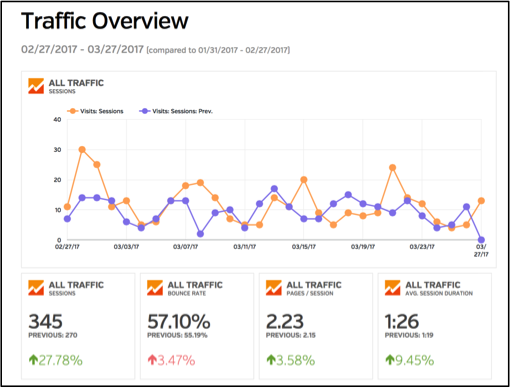As account managers in the Emerging Digital department of Wpromote, we use many different types of reporting tools to convey the state of client websites and the improvements we’ve attained on a monthly basis.
One of the reports we commonly use is called an MR (Monthly SEO Report). This report has a lot of data and uses some jargon you may not be familiar with.

To help you better digest this report, here is a breakdown of two key areas of understanding—types of traffic and visitor engagement.
Types of Traffic
In order to understand your report, first you must become familiar with the types of traffic coming to your website. For your reference, there are three main types of traffic your website can get that contribute to your overall traffic data:
- Organic Traffic
- Direct Traffic
- Referral Traffic
Organic traffic is a direct result of your SEO (Search Engine Optimization) efforts. SEO is rooted in optimizing your site for quality content, keyword strategy, and user interface/visitor engagement. The result of good SEO leads to you ranking higher in the search results pages when people type in keywords related to your business. For example, if you are an orthodontist in the city of East Orange: “east orange orthodontist.”
Higher ranking positions on the search results pages lead to more visitors on your website. And optimized, diversified content leads to longer visits, which results in a greater likelihood that these visitors will convert into new clients/business.
Meanwhile, direct traffic is the result of someone typing in your exact website name into the URL search bar (example: www.heartpastaorthodontist.com). Lastly, referral traffic reflects the visitors that end up on your website by clicking on a link to it (like on your Facebook page, Yelp, a directory, etc.).
Accordingly, from an SEO standpoint, out of these three options we want your organic traffic to be your greatest percentage of traffic because people who already know your URL/website name (direct traffic visitors) and who link to your site from, say, your Facebook page (referral traffic visitors) are more likely to already be clients. Conversely, with organic traffic, visitors who may never have heard of you can find you naturally because they were simply searching for keywords related to your business.
Visitor Engagement
Now let’s talk about the quality of that traffic—the visitor engagement. Quality of traffic/engagement is measured in part by:
- How long people stay on your website per visit (average session duration time)
- How many pages they visit while they are there (pages-per-session ratio)
- Bounce rate (a bounce basically signifies someone who leaves your site immediately or very quickly, so the lower the bounce rate the better)

The more engaged a visitor is, the more likely he or she is to become a client of your business. This type of engagement is dependent on how well your SEO is constructed in terms of content and site user interface.
You & Your Reports
Types of traffic and visitor engagement are two cornerstones of understanding that will help you interpret the results of your monthly SEO efforts, as illustrated on your MR. Now, another key report that managers use to illustrate your SEO improvements is a KRR, or a Keyword Ranking Report.







Responses